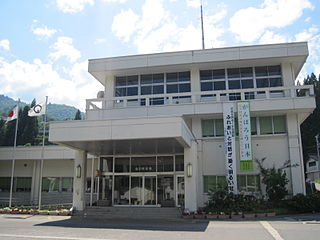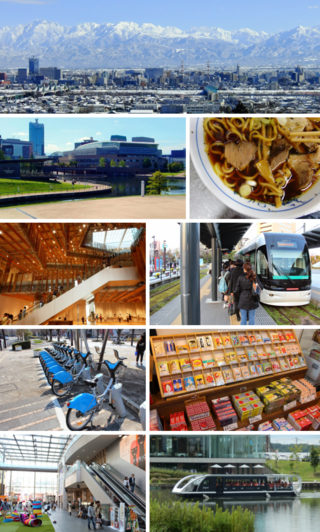Graphs are unavailable due to technical issues. There is more info on Phabricator and on MediaWiki.org. |
The following is a list of dams in Toyama Prefecture, Japan.
Graphs are unavailable due to technical issues. There is more info on Phabricator and on MediaWiki.org. |
The following is a list of dams in Toyama Prefecture, Japan.

The Chūbu region, Central region, or Central Japan is a region in the middle of Honshū, Japan's main island. In a wide, classical definition, it encompasses nine prefectures (ken): Aichi, Fukui, Gifu, Ishikawa, Nagano, Niigata, Shizuoka, Toyama, and Yamanashi.

Toyama Prefecture is a prefecture of Japan located in the Chūbu region of Honshu. Toyama Prefecture has a population of 1,044,588 and has a geographic area of 4,247.61 km2. Toyama Prefecture borders Ishikawa Prefecture to the west, Gifu Prefecture to the south, Nagano Prefecture to the east, and Niigata Prefecture to the northeast.
Toyama may refer to:

Shirakawa is a village located in Ōno District, Gifu Prefecture, Japan. It is best known for being the site of Shirakawa-gō, a small, traditional village showcasing a building style known as gasshō-zukuri. Together with Gokayama in Nanto, Toyama, it is one of UNESCO's World Heritage Sites.

Tateyama is a town located in Nakaniikawa District, Toyama Prefecture, Japan. As of 1 October 2016, the town had an estimated population of 26,212 in 9452 households and a population density of 85 persons per km². The total area of the town was 307.29 square kilometres (118.65 sq mi).

The Kurobe River is a river in Toyama Prefecture, Japan. The river is 86 kilometres (53 mi) in length and has a watershed of 689 square kilometres (266 sq mi).

Mount Tate, also known as Tateyama, is a mountain located in the southeastern area of Toyama Prefecture, Japan. It is one of the tallest mountains in the Hida Mountains at 3,015 m (9,892 ft) and one of Japan's Three Holy Mountains along with Mount Fuji and Mount Haku. Tateyama consists of three peaks: Ōnanjiyama, Oyama, and Fuji-no-Oritate, which form a ridge line. Tateyama is the tallest mountain in the Tateyama Mountain Range.

Toyama is the capital city of Toyama Prefecture, Japan, located on the coast of the Sea of Japan in the Chūbu region on central Honshū, about 200 km (120 mi) north of the city of Nagoya and 300 km (190 mi) northwest of Tokyo. As of 1 June 2019, the city had an estimated population of 415,844 in 176,643 households, and a population density of 335 persons per km2. Its total area was 1,241.77 square kilometres (479.45 sq mi).

Toyama Station is a railway station in Toyama, Toyama Prefecture, Japan, operated by West Japan Railway Company. It is the largest and busiest railway terminal in Toyama.

The Arimine Dam is located in Toyama, Toyama Prefecture, Japan built upon the Wada River. The two bends in the middle of the dam is the most defining feature. The Arimine Lake is an artificial lake that was created by construction of the dam.

The Shō River has its source in Mount Eboshi in the Shōkawa-chō area of Takayama, Gifu Prefecture, Japan. After flowing for 115 km (71 mi) through the northern part of Gifu Prefecture and the western part of Toyama Prefecture, it empties into Toyama Bay.

Sakaigawa Dam is a dam in Nanto, Toyama Prefecture and Shirakawa, Gifu Prefecture, Japan. It is named for the Sakaigawa River, upon which it is built. The dam has an associated 27 MW hydroelectric power station about 2.9 km (1.8 mi) downstream. It was commissioned in June 1993.

The Wadagawa Dam is a gravity dam on the Wadagawa River in Tonami, Toyama Prefecture, Japan. It was constructed between 1962 and 1967. The dam has an associated 7.4 MW hydroelectric power station which was commissioned in 1968. Of the dams in the Shō River system, it is the furthest downstream.